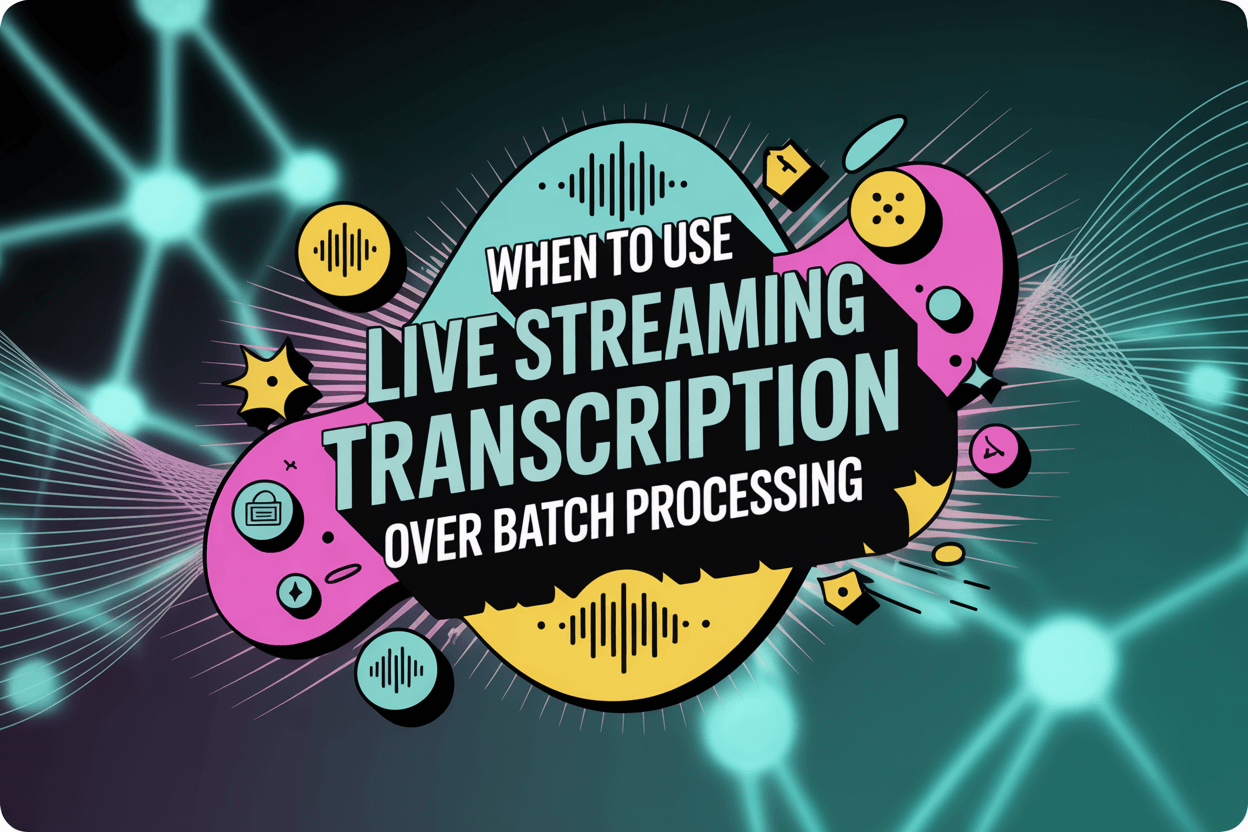Debe utilizar transcripción en directo cuando necesite salida de texto en tiempo real, por ejemplo, durante reuniones en directo, seminarios web o retransmisiones. Procesamiento de lotes de transcripción, en cambio, es mejor para archivos pregrabados que puedan procesarse después de un evento. La elección correcta depende de si valoras acceso inmediato o precisión posterior al evento.

⚡ ¿Qué es la transcripción en directo?
Transcripción en directo convierte las palabras habladas en texto a medida que se pronuncian. Utiliza modelos de reconocimiento del habla en tiempo real que capturan, procesan y muestran el texto en cuestión de segundos. Esto resulta especialmente útil cuando los participantes o espectadores necesitan subtítulos o notas inmediatos.
🔸 Casos de uso común
- Seminarios web en directo y eventos virtuales
- Formación y conferencias en línea
- Llamadas de atención al cliente en directo
- Subtítulos de accesibilidad en tiempo real
La transcripción en tiempo real ayuda a los equipos a mantenerse comprometidos e informados al instante. Sin embargo, como da prioridad a la velocidad, puede ser algo menos preciso que los métodos por lotes, sobre todo en entornos ruidosos o con varios interlocutores.
🧠 ¿Qué es la transcripción por lotes?
Transcripción por lotes - también conocida como transcripción asíncrona u offline - procesa grabaciones de audio o vídeo después de la sesión haya finalizado. En lugar de resultados inmediatos, el sistema analiza todo el archivo antes de producir una transcripción, lo que garantiza una mejor puntuación, precisión y separación de los hablantes.
🔸 Casos de uso común
- Transcripción de podcasts y entrevistas
- Archivos de reuniones de empresa
- Grabaciones de investigación académica
- Conversiones de grandes bibliotecas multimedia
Este método funciona mejor en proyectos en los que la precisión, el formato y el contexto importan más que la velocidad. Es la solución ideal para organizaciones que gestionan grabaciones largas o documentación detallada.
⚙️ Live vs Batch: Diferencias clave que debe conocer
| Característica | Transcripción en directo | Procesamiento por lotes Transcripción |
|---|---|---|
| Velocidad | Salida instantánea en tiempo real | Con retraso pero a fondo |
| Precisión | Moderado | Superior (consciente del contexto) |
| Escalabilidad | Ideal para sesiones en directo | Ideal para grandes bibliotecas |
| Casos prácticos | Reuniones, seminarios web | Investigación, postproducción |
| Requisitos de Internet | Siempre es necesario | Puede ser offline o en la nube |
Resumiendo:
- Elija transcripción en directo cuando el momento es crítico.
- Elija transcripción por lotes cuando la precisión y la escalabilidad son lo más importante.
🚀 Uso de VOMO.AI tanto para la transcripción en directo como por lotes
Si necesita una herramienta que admita flujos de trabajo en tiempo real y por lotes, VOMO.AI es una de las mejores opciones. Su motor de transcripción basado en IA puede capturar sesiones en directo y, al mismo tiempo, permite cargas masivas para el análisis posterior al suceso.
Los equipos pueden transcribir fácilmente archivos completos de reuniones, conferencias o entrevistas manteniendo la precisión y el formato. Con VOMO.AI, los usuarios pueden manejar tanto de audio a texto y vídeo a texto en tiempo real o por lotes.
🎯 ¿Cuándo se debe utilizar la transcripción de retransmisiones en directo?
Debe utilizar transcripción en directo cuando:
- El público necesita subtítulos inmediatos.
- Quiere accesibilidad en tiempo real para usuarios con problemas de audición.
- Necesita documentación en directo para actos, charlas o conferencias.
- Tiene previsto integrar la salida de texto con flujos de vídeo en directo o chatbots.
Por ejemplo, durante un seminario web global, la transcripción en directo garantiza que todos los participantes puedan seguir el debate, independientemente del acento o el ruido de fondo.
💼 ¿Cuándo es mejor el procesamiento por lotes?
Utilice transcripción por lotes cuando tenga contenidos grabados que no requieran subtítulos en directo pero necesiten un transcripción limpia y precisa después. Esto incluye podcasts, entrevistas grabadas o grandes archivos de vídeo.
El procesamiento por lotes es ideal cuando:
- Tienes horas de medios para procesar a la vez.
- Necesita datos estructurados, marcas de tiempo o resúmenes.
- Su atención se centra en la documentación, el cumplimiento o el análisis.
🧩 Cómo elegir el flujo de trabajo de transcripción adecuado
El enfoque ideal depende de su flujo de trabajo:
- Por velocidad: Ir con transcripción en directo.
- Por precisión: Elija procesamiento por lotes.
- Por su versatilidad: Utilice plataformas como VOMO.AI, que le permiten alternar entre ambos en función del proyecto.
Los sistemas modernos de IA permiten incluso configuraciones híbridas: transcripciones en directo durante los eventos, guardadas automáticamente y refinadas más tarde mediante reprocesamiento por lotes para mejorar la precisión.
✅ Reflexiones finales
Decidir entre la transcripción de secuencias en directo y el procesamiento por lotes depende de su necesidades de tiempo, expectativas de precisión y volumen de trabajo. Si organizas eventos en directo o reuniones virtuales, la transcripción en tiempo real mantiene una comunicación fluida. Para archivar y documentar, la transcripción por lotes garantiza un resultado fiable y pulido.
Con soluciones avanzadas como VOMO.AI, No tiene por qué elegir uno en lugar del otro: puede gestionar eficazmente ambos en un solo lugar, garantizando una transcripción rápida, precisa y escalable para cada caso de uso.



